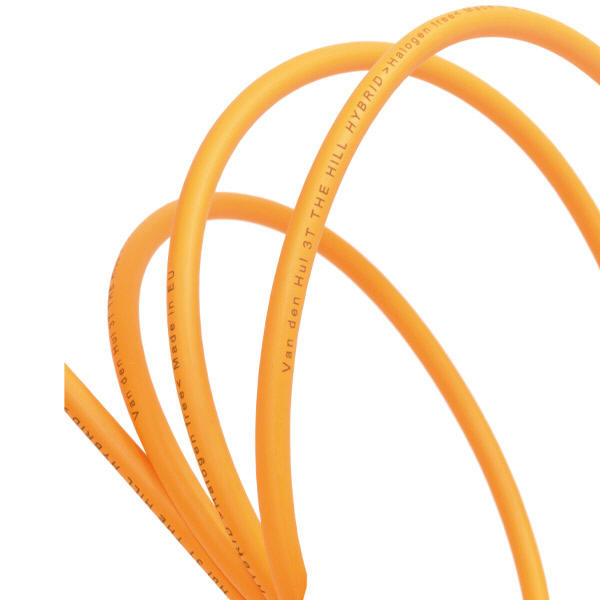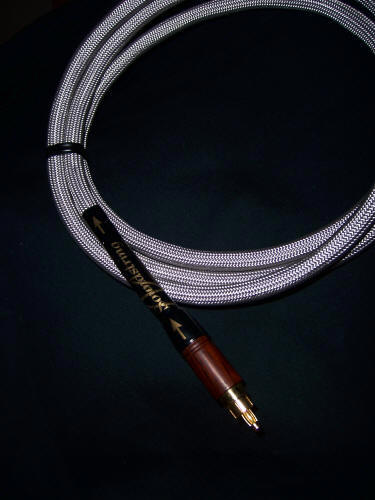|
You are reading the older HTML site
Positive Feedback
ISSUE
58
Van den Hul The Rock Hybrid Cables and Soundstring
GEN II Cables - Can a Legendary Audio Secret Surpass Itself? Who Doesn't Root
for an Overachieving Underdog?
Van den Hul's Ongoing Ascent Over more than two-plus decades of recording in the field live to two track before live to multi-track) I've depended over and over on the absolute "audio neutrality" of Van den Hul cables at the crucial signal transfer point in my portable rig's set up logic. The legendary Van den Hul Second came to be not merely a 'constant' in my work. It carried out the virtually inexplicable duty of solving signal transfer problems that involved issues of "too much" this or unwanted "that." In short, Van den Hul's "linear structured carbon" technology design has an alluring, truly mysterious signal rectitude and musically nuanced reliability without near equal. I mean that the patented carbon technology at the heart of Van den Hul's signal delivery owns a unique dynamic property seldom if ever approached. Both ensemble power and the peaks and swoops of individual instruments and voices appear whole, coherent, resolved to a burnished raw maximum via what the Van den Hul folks call their LINEAR "structured" technology configuration.
I have no clue in the least what that is or what, with the aid of hermeneutic, technological or allegorical deconstruction, it indicates at the minimal quick of materials science and abstruse mathematical analysis. I do know, however, that I've cherished every foot and meter of these cables, whether they were balanced pairs (standard recording XLRs in and out) or somewhat specially reconfigured (XLR to phone jack ¼" termination) pairs. The carbon cable signal delivery has a wonderful audio honesty (or accuracy) that words cannot capture. I found many years ago that long runs of Van den Hul speaker cables also create the "spectrally resolved, spatially integrated" soundstage properties that my various pairs of Van den Hul recording cables bring to "on location" recordings. Enter now, stage right, Van den Hul's drop dead quiet The Rock hybrid cable. I requested a three meter balanced pair so that I could make direct to two track recordings using only that single pair of signal transfer conduits with a superior pair of microphones. My first field test employed Crowley and Tripp's ultra-sensitive tube-ribbon mics. I recorded Gilbert Castellanos' Bolero Sextet, a challenge to the max with two mics because that mature and seductive ensemble features the lithe and gorgeous voice of Lorraine Castellanos... and, in this context, "lithe" carries the nuances of her subtle calm and quiet sensual articulation. I've not had an opportunity to duplicate that recording configuration with a different pair of ultra high-grade audiophile quality microphone cables, but I'm hard pressed in the abstract to imagine another cable as dead quiet in its signal pick up. One or two very (very) expensive mic cables come to mind as obvious nominees for such comparison, but I have not had that tantalizing chance yet. Truth being one's best ally, I'll admit that the only cables that seem potentially able to approximate or equal The Rock's musical glory and sonic self-effacement are Stealth's version of carbon signal transfer and Kubala-Sosna's awe-inspiring Elation cables. A third contender would be Silversmith's Platinum cables. In each case, we're looking at significantly greater cost, but I'll stake my understanding of the audio resolution under scrutiny here to something this simple: I do not know any cables, for all the inevitable differences in signal transfer and musical outcome that different cables create, superior to those I've named here. To say that I'm "taken with" The Rock 's authority in all the crucial as well as in the ancillary acoustic areas where the life and truth of "on location" recordings hang in the balance is to understate my admiration. If I were to choose (or to be lucky enough to have "at") a complete set of The Rock cables of various configurations in order to thoroughly "wire" an entire sound system, I have no doubt that the sonic and musical outcome of that front to back (top to bottom; wall to wall) cabling network would be spectacular... in fact, an experience that might prove (as all superior aesthetic and sensuous experiences do) to define a certain boundary of sonic awareness, joy and comprehension. I'm not able to test my suspicion pragmatically. But I'll lay claim to a semi-audacious hope that stands as a barely covert proposition. Years ago I offered an audio hardware company the prospect of creating the recording set up for a full signal capture of a live concert using their gear front to back. I shared that idea with the CEO of the company in a conversation at the AES Show in New York. His enthusiasm seemed genuine. What transpired over time was a moment's possibility endlessly deferred. I was later told by a confederate of his that the once enthusiastic CEO grew paranoid thinking that the down side of his company's equipment coming up short of its widely-advertised claims outflanked his cheerful hope that a major victory "under fire" would emerge. The decision was to forego trust in his products and hunker down into a campaign of untested claims and assertions. We all know that word of mouth sells more products than ad campaigns; that the certification of direct and proven experience both outlives and outreaches hype and all promo bravura. Under the pressure of practical knowledge resulting from experimental discovery, the truth emerges for everyone to recognize. Here are two examples in the audiophile world: are there any products that have passed the "no bullshit" test more often, longer and with greater numbers of satisfied foot soldiers in the army of their confirmation than LINN's classic, now legendary LP-12 turntable and Richard Vandersteen's indefatigable 2Ce speakers? These audio products literally set the standard for long-lasting product durability and customer satisfaction. My semi-(non)covert proposition here relates to all this. If given the chance, I'd accept the offer to make a full-out "on location" high-resolution recording with Van den Hul's The Rock cables at each point in my recording chain. This will likely not happen, but my inclination for that possibility has everything to do with my firm belief in these carbon-based cables... that something magical, which has proved itself to me time and again over a quarter century at a much less complete level of use and testing, will again appear—this time in spades and to the third power. The "something magical" I point to here, somewhat cryptically, is an inherently musical footprint, free of distortion, color or spectral exaggeration. The Rock has shown itself in my experience (one example cited above; more than that not listed here) to be far more than "a contender," as Marlon Brando's famous frazzled chump in On the Waterfront once lamented as all prospect of such success dissolved. The Rock is a champ. Its sonic authority derives from whatever the technological innovations, the aesthetic subtlety, and the innate musical heart it has been bred to demonstrate and enforce all carry forward. Did I mention that The Rock deserves more than a glancing interest from anyone who cares deeply about sound at its best and music of any well-recorded sort? Did I note that—given the unexpected chance to use these cables end to end in the exercise of creating a world class "live" recording—I'd do just that... and bet the Christmas turkey (Shelton, basted with cognac) that the outcome will flabbergast even his truly legendary and premier eminence, Maestro A. J. Van den Hul himself ! Soundstring's Gentles Astute Lift Off I've reviewed the emerging escalation of Soundstring Cables across a number of years ever since I essentially stumbled onto their ridiculously modest self-definition. I was taken by the way that Soundstring's GEN I cables created spectral balance all along the twenty-to-twenty signal path. Hose cables did not own the remarkable openness and transparency their Gen II successors do, but they were blessed with no irritating peaks or depreciation troughs along the spectrum. Their virtue was enhanced by their modest price... a virtue sustained in the new generation of cables. I have done many recordings with long runs of Gen I mic cables. Any studio or recording engineer who will take the time to put those cables up against industry standard cables (Belden; Mogami, Canare; Monster) will need a dentist to help crack his jaw back into place. No comparison. Silly and ridiculous slam dunk "no contest" between them, since Soundstring's musical transfer is genuinely "musical." Here is one concrete indication of the difference involved here: no EQ is required in 90+ % of the signals delivered through the Gen I cables. Try that with the others. Good luck.
Shown is the interconnect Gen II mic cables, and I'm talking about 40 and 50 foot long runs, are quieter than the earlier cables. Their openness and, therefore, their clarity and musical vivacity are enhanced. Our new university Performing Arts Hall is decked out with hundreds and hundreds of meters of the Gen I cables (I wish it was Gen II) and I can attest to my satisfaction with the PA sound we've achieved in a new state-of-the-art concert hall as well as my satisfaction with recorded sound under somewhat complex and challenging technical conditions. You get high quality musical signal delivery for a fraction of the cost of the Big Four cables named above. Believe, I'm all for THE BEST when its within reach. But in real world pragmatic contexts, in which price determines possibilities, Soundstring's XLR interconnects and mic cables (along with its RCA interconnects) allow someone with a discerning ears and good taste lacking deep pockets to approach the top of the signal delivery food chain. I adore underdogs, especially scrappy big-hearted entries to the ongoing bluster of the world's constant competition. Soundstring's newly reworked and now hugely over-reaching technical and aesthetic success gives pause to anyone willing to throw money around without adequate diligence. I hereby attest that this company's continuous search for improvement has quite likely not hit a wall, but it certainly has brought to market a set of cable products that have made a believer our of my stubborn, skeptical resistance. If the price point for the ultra-best Roll Royce cables is out of the question, anyone who is not familiar with Soundstring's newly enhanced GEN IIs may do himself a considerable favor to check these out. The difference between state of the art cables and cables with what may be the most rewarding price to value ratio has recently grown smaller. It gives me sincere delight to deliver such news to a world always starving for more and better music, more seductive and better recorded sound.
|


